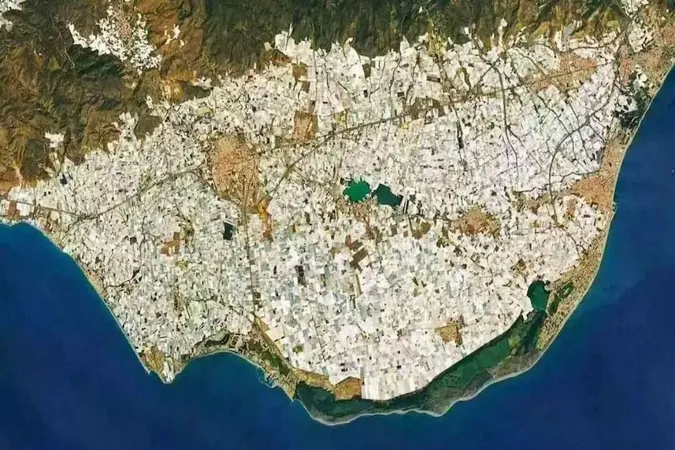
Europe's Plastic Sea: The Largest Man-Made Structure Visible from Space!
2025-07-18
Author: Noah
When astronauts peer down from the International Space Station, one astonishing structure captures their attention—not the Pyramids of Egypt or the Great Wall of China, but a massive expanse of white plastic covering Almería in southern Spain. This extraordinary feat of agriculture, dubbed the “Sea of Plastic,” has evolved into the largest human-made construction detectable from space, transforming a once barren landscape into Europe’s flourishing vegetable garden.
A Surprising Giant in Plain Sight
Forget what you thought you knew about visible landmarks from space! While tourists flock to iconic wonders, astronauts turn their sights to Almería's greenhouse complex—its gleaming white roofs spanning over 40,000 hectares (around 100,000 acres) reflect sunlight back into the cosmos, creating a dazzling beacon easily seen from hundreds of kilometers up. Spanish astronaut Pedro Duque even hailed this area as one of Europe’s most recognizable features.
The Genesis of a Greenhouse Revolution
What's truly remarkable is the relatively short timeline of this agricultural marvel. Unlike ancient monuments crafted over eons, the transformation of Almería began in the 1960s, illustrating a rapid and visible alteration of the landscape. NASA regularly captures this noteworthy footprint in their images, highlighting its significance.
From Wasteland to Agricultural Powerhouse
Once among Spain’s poorest regions, Almería's semi-arid conditions posed significant agricultural challenges, including less than 200mm of rainfall annually, damaging winds, scorching summer heat exceeding 40°C, and sandy soil with minimal fertility. The greenhouse revolution kicked off in 1959 when entrepreneur José Hernández Buj introduced an affordable greenhouse model inspired by Belgian designs, paving the way for year-round cultivation in this erstwhile inhospitable environment. Today, Almería produces between 2.5 and 3.5 million tons of fruits and vegetables each year, fueling a massive export industry that feeds much of Europe.
Beyond the Greenhouses: Technological Triumphs
Almería's greenhouses are far more than mere plastic structures; they are technological marvels featuring advanced drip irrigation systems, computerized climate controls, and integrated pest management practices. This sophisticated approach maximizes yields while minimizing resource consumption. However, the intense agricultural activity also raises critical questions about consumerism’s impact on the environment.
Navigating Environmental Challenges
The Sea of Plastic presents a complex environmental narrative. Critics voice concerns about intensive agriculture, likening Almería's challenges to those faced by other agricultural export zones like Guatemala. But the region is making strides toward sustainability, with many farms earning environmental certifications. Labor conditions also complicate the picture, with a workforce largely comprised of migrants, echoing social issues found in other agricultural powerhouses.
Innovating for a Sustainable Future
As Almería continues its agricultural journey, it may become a blueprint for sustainable intensive practices. Innovations on the horizon include solar-powered desalination techniques, biodegradable coverings, and carbon capture technologies integrated within greenhouse operations.
A Global Perspective on Agricultural Practices
In a world increasingly affected by climate change, Almería offers valuable insights for regions facing similar arid conditions, potentially shaping the future of food security as climate refugees continue to rise. The striking visible impact of these greenhouses serves as a potent reminder of humanity's ability to reshape landscapes and respond to environmental challenges.
By balancing productivity with reduced ecological footprints, Almería stands as both an inspiration and a cautionary tale. This shining sea of plastic is not just a sight from space; it encapsulates a profound mission—creating abundance where once there was scarcity while grappling with the environmental effects of such dramatic transformation.









 Brasil (PT)
Brasil (PT)
 Canada (EN)
Canada (EN)
 Chile (ES)
Chile (ES)
 Česko (CS)
Česko (CS)
 대한민국 (KO)
대한민국 (KO)
 España (ES)
España (ES)
 France (FR)
France (FR)
 Hong Kong (EN)
Hong Kong (EN)
 Italia (IT)
Italia (IT)
 日本 (JA)
日本 (JA)
 Magyarország (HU)
Magyarország (HU)
 Norge (NO)
Norge (NO)
 Polska (PL)
Polska (PL)
 Schweiz (DE)
Schweiz (DE)
 Singapore (EN)
Singapore (EN)
 Sverige (SV)
Sverige (SV)
 Suomi (FI)
Suomi (FI)
 Türkiye (TR)
Türkiye (TR)
 الإمارات العربية المتحدة (AR)
الإمارات العربية المتحدة (AR)